Self Help
Alternative Medicine
Aryuvedic Principles of Self-Care
Self-care, as the word implies, it is about taking care of oneself. For an individual to give their best in everything they do and to enjoy their life to the fullest, they need to be healthy physically and emotionally. Self-care is all about spending time doing things that help to improve our physical and emotional health. Factors that impact overall health include diet, exercise, stress management, sleep, and interpersonal relationships.
Practicing self-care regularly is possible by creating a daily routine focused on meal timings, sleep, physical activity, and time spent on activities that help de-stress. A daily routine can be customized based on an individual’s needs while keeping a bigger picture of healthy habits and timings in mind. Cultivating healthy habits by incorporating them gradually helps you stick to those habits longer, instead of starting all of them at once.
Read through the Weekly Plan and the exercises below to get started on incorporating these alternative medicine principles into your life.
Weekly Plan and Objectives
Week 0
- Begin this week by noting down your current lifestyle:
- Eating habits, which include timings and the type of foods you currently consume
- Sleep timings (bedtime, wake-up time in the morning)
- Exercise routine (If you already have one)
- Go through the information provided about the importance of having a daily routine, pranayama types and procedures, and yoga asana types and procedures.
The objective for the end of week 0: Getting familiar with the daily routine, pranayama, and asanas.
Week 1
- Start waking up early between 5 am to 6:30 am
- Practice pranayama twice a day (morning & bedtime)
- Practice yoga asanas recommended twice a day, in the morning and at bedtime.
- At least 30 minutes of physical activity such as walking, biking, running, etc., at least five days a week.
- Cut down on processed foods and include whole foods.
- Eat breakfast between 7 am to 9 am
- Lunch between 11 am to 2 pm
- Dinner between 6 pm to 8 pm
- Sleep by at least 10 or 11 pm during weekdays.
The objective for the end of week 1: Workout routine and pranayama routine are established
Week 2
- Double the time you practice pranayama and yoga asanas.
- Eating and sleep timings are established and try to stick to the routine as much as possible.
The objective for the end of week 2: Fixed mealtime and sleep time routine are established and are implemented at least 2 to 3 days per week. Noticeable reduction in stress and anxiety levels by the practice of daily routine, yoga & pranayama.
Week 3 & Week 4
- Continue working on daily routine, and practice yoga and pranayama at least 5 days a week.
The objective for the end of week 4: Fixed mealtime and sleep time routine are improved at least 4 days per week compared to week zero. Continued noticeable reduction in stress and anxiety levels and improved sleep quality by practicing recommended changes at least 5 days a week.
Week 5 & Week 6
Same as weeks 3 and 4.
The objective for the end of week 6: Reduction in stress and anxiety levels, improvement in sleep quality and length, improvement in an overall feeling of wellbeing, and reduction in negative thinking compared to week zero.
Diet: Start your day by drinking water that is at room temperature/warm. It helps to stimulate the digestive system. After drinking water, wait at least 30 minutes before you eat anything. Eat breakfast, lunch, and dinner around the same time every day. Practicing fixed meal timings helps for better digestion and absorption of the nutrients and helps to avoid overeating.
The foods we consume can affect our physical and emotional health. A diet that includes whole foods, and fresh produce that is seasonal and locally grown helps to improve gut health by favoring the growth of good gut bacteria. We get more nutrients by consuming locally grown, seasonal fresh produce. Eating healthy by making the right food choices and eating at the right times can help to digest and assimilate nutrients well and helps you feel more energetic throughout the day. Other tips to improve your diet:
- Include at least 3 to 5 servings of vegetables and 2 to 3 servings of fruits in a day.
- Cut down on processed foods and replace them with whole foods.
- Avoid snacking in between meals.
- Avoid skipping meals and eating late dinner.
- Eat at least three hours before you go to bed. It helps with better digestion and sleep.
Sleep: Sleep helps to restore, rejuvenate, and repair the body and mind. A lack of good quality sleep (6 to 8 hours) can make you feel tired physically and emotionally throughout the day. Schedule a sleep routine and try to stick to the routine maximum number of days in a week. Practicing breathwork and yoga poses (discussed below) at bedtime can help you sleep better.
Physical Activity: Regular physical activity helps to improve both physical and mental health. Adults need a minimum of 150 minutes of moderate-intensity aerobic activity per week. Regular physical activity even for a shorter duration of time can reduce the symptoms of anxiety and depression. Along with regular exercise, including yoga asanas (poses) and Pranayama (controlled breathing) in your daily routine and practicing them on a regular basis can have a greater impact on improving the overall health and quality of life.
Pranayama (Yogic breathing)
The word Pranayama (yogic breathing) is a combination of two words, Prana meaning “life force” and Yama meaning “control”. Pranayama means regulating the breath. Pranayama is one of the eight limbs of yoga. There are many different types of pranayama (breathing techniques), and it is always advisable to practice pranayama under the supervision of a trained instructor. Some of the pranayama types are simple and some are more advanced and complex.
Studies show that Pranayama, namely Dheerga, Nadishodhana, and Bramari pranayama reduces stress, anxiety, and negative thinking along with many other physical and psychological health benefits. Regular practice of slow-paced breathing techniques helps to improve self-regulation, positive mood, and reduced stress and anxiety levels. It helps to improve respiratory function, improve heart health, reduce blood pressure, stress, and anxiety, and improve sleep. The pranayama mentioned below can be practiced twice a day, in the morning before breakfast and at bedtime, to reap its maximum benefits. Start by doing each pranayama for a minimum amount of time and gradually increase the time.
Dheerga (Deep breathing)
Step by step instructions:
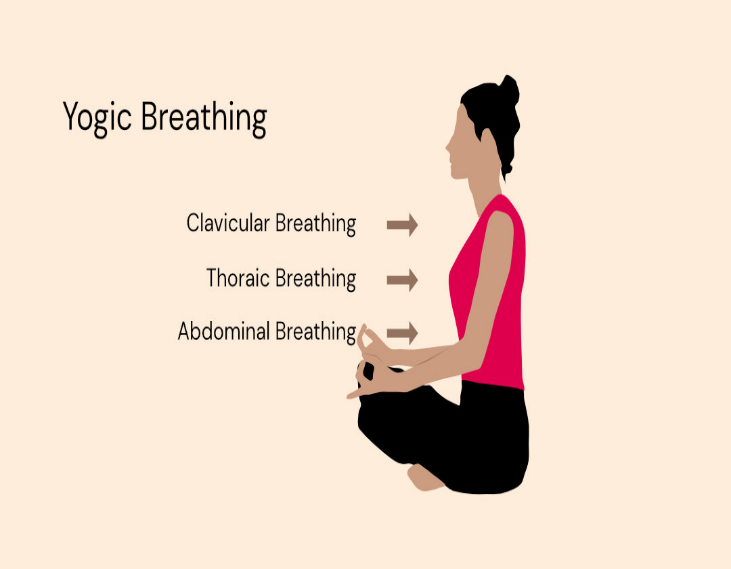
- Sit in a comfortable position with your spine straight, with your chin parallel to the ground. You can either sit on the ground or on a chair.
- You can also sit on a cushion to support your pelvis.
- Now close your eyes and scan your body to see tightness anywhere in the body. Relax your shoulders and wherever you feel the body is tight.
- Now start focusing on your breath. Gently try to breathe deep while you inhale and exhale.
- After a couple of slow breaths, on your next inhalation, try inhaling a slow deep breath and exhale longer than your inhalation.
- As you inhale allow your lungs to fill with the air drawing the air all the way to your lower lungs.
- As you exhale observe that your belly deflates like a balloon.
- Continue breathing while focusing on your breath, and the breathing process should be smooth and easy.
- You can keep your right hand on your chest and your left hand on your belly button to feel the expansion and contraction of your belly and chest while you inhale and exhale.
It is called three-part breathing, since while inhaling, you fill air into your lower, middle, and upper lobes of your lungs and exhale by letting the air out in reverse order. Practice this breathing technique for one to three minutes. It is recommended to practice it first thing in the morning and at bedtime. You can also do this anytime during the day when you feel stressed or anxious.
Nadishodhana/Anulom - Vilom (Alternate nostril breathing)
Step by step instructions:
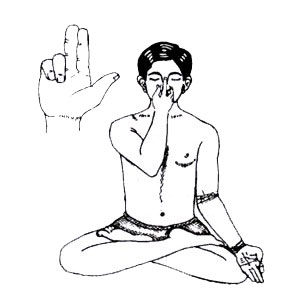
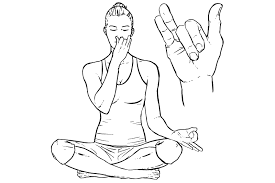
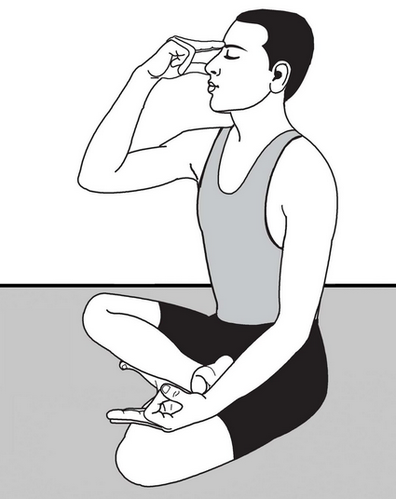
- Continue the same posture as above.
- Close your right nostril with your right thumb, inhale slowly and deeply through the left nostril.
- Close it with your ring and little finger, keep the middle and index fingers on a spot between your eyebrows.
- Now release your thumb from the right nostril to exhale.
- Keep the right nostril open and inhale through it and close it with thumb again and open and exhale through the left nostril.
- This is one cycle. Keep repeating this cycle several times.
- You can also do this by folding the index and middle finger instead of keeping them on the spot between eyebrows.
- Take a break if you need to resume normal slow deep breathing through both the nostrils.
- Practice this breathing technique for three to five minutes.
- As you get more comfortable and if you have more time, you can extend the practice to 15 - 20 minutes.
Bramari (Bee breathing)
Step by step instructions:
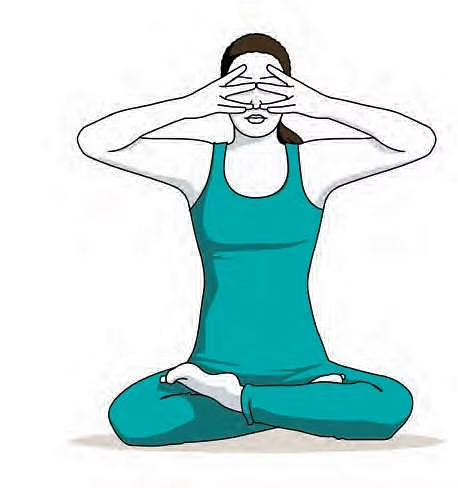
- Sit in a comfortable posture with your spine straight and eyes closed.
- Now close your right and left ears by pushing the tragus with your thumbs.
- Place the index fingers just above your eyebrows on both sides and place the rest of the fingers on your eyes applying gentle pressure on the side of the nose. Concentrate your focus in between your eyebrows. Now breath in through the nose, while keeping your mouth closed.
- Breathe out through the nose while making a humming noise.
- Repeat the process three to five times.
- As you get more comfortable, you can increase the number of times to eleven times.
Yoga Asanas to relieve stress and improve sleep
Forward fold (Uttanasana)
Procedure:
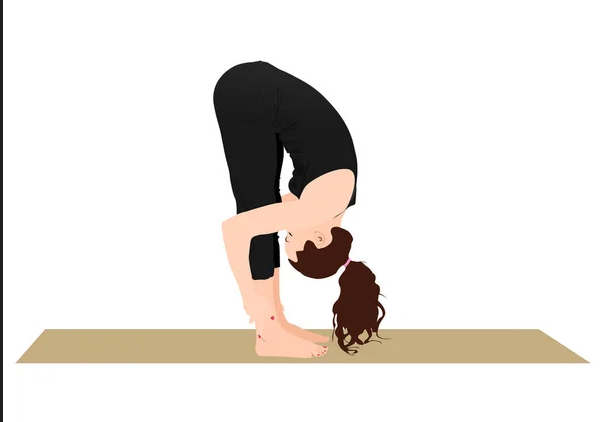
- Begin by standing on the mat with your feet placed hip- width apart.
- Now lift your arms up and over your head as if you are trying to reach the roof.
- Inhale and try to reach up the ceiling with your hands stretching your spine
- As you exhale, bend at the hips and with your hands stretched, try to reach your toes/ shins/ankles with your fingertips.
- Don’t push yourselves too hard to reach your toes. For some, it takes a long time of steady practice to be able to touch the toes or the ankles.
- Stay in that posture for 30 to 90 seconds. Keep breathing while you hold the position. Slowly release the pose, come up while breathing in, as you keep your hands extended reaching up to the sky.
- Inhale when you extend, exhale when you flex. But when you want to stay for a while in a particular pose, don’t forget to keep breathing.
Balasana (Child’s pose)
Procedure:
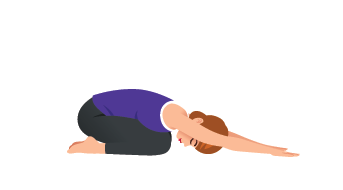
- Start with kneeling on the mat with your knees while keeping your spine straight.
- Now sit back on your heels. Your knees should not be touching each other, keep them hip-width apart.
- Now lower your body onto the thighs and head towards the mat.
- Keep your hands on either side of the legs with palms facing up. You can also stretch your hands out to either side of the head.
- The modified pose for beginners can be done by placing a pillow between your calves and thighs, and another pillow can be used to rest your head. Stay in that position for 30 to 90 seconds. Slowly release the pose by sitting up back on the heels.
- Inhale when you extend, exhale when you flex. But when you want to stay for a while in a particular pose, don’t forget to keep breathing.
Viparita Karani (Legs up the wall)
Procedure:
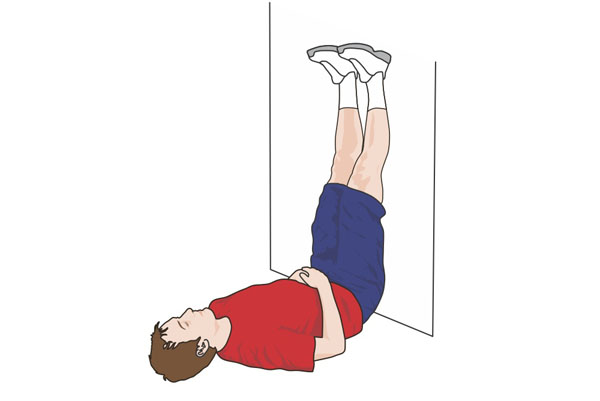
- Lay down on your back on a mat/blanket close to the wall while stretching your legs up against the wall. Keep your feet hip- width apart.
- You can keep your hands on your belly or on either side of your body.
- Stay in this position for about 30 to 90 seconds.
- Slowly come back to your normal position by releasing the legs from the wall while turning your body on to one side.
- You can use a folded blanket under your hips for added comfort.
- When you want to stay for a while in a particular pose, don’t forget to keep breathing.
Sethubandasana (Bridge pose)
Procedure:
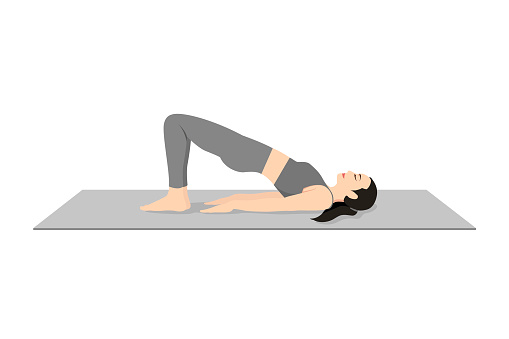
- Start by lying on your back on a mat. Now bend your knees while keeping your feet flat on the floor hip width apart.
- Place both hands on either side of your body.
- Lift your hips and spine from the floor while pressing your feet onto the floor while inhaling.
- Stay in that position. Lift the chest up further by pressing the hands and feet on to the floor.
- Keep breathing while in that position. Hold this position as long as you can.
- To release from the pose, exhale and roll the spine to the floor. Repeat the pose as many times as you would wish.
- Inhale when you extend, exhale when you flex. But when you want to stay for a while in a particular pose, don’t forget to keep breathing.
Shavasana (corpse pose)
Procedure:
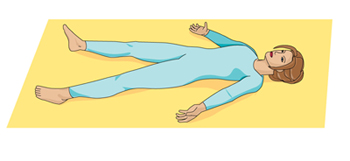
- Start by lying down on the floor.
- Keep your arms on either side of your body with palms facing up.
- Close your eyes and relax. Relax your jaw and face.
- Let your body relax while you breathe slowly and deeply.
- Stay in this position for at least 60 to 90 seconds.
- Turn on to a side before you sit up.
- This pose is generally done at the end of yoga session.
Further Reading and Resources
References
- https://www.ncbi.nlm.nih.gov/pmc/articles/PMC3415184/
- https://bmcmededuc.biomedcentral.com/articles/10.1186/s12909-018-1296-x
- https://www.ncbi.nlm.nih.gov/pmc/articles/PMC7336946/#
- https://www.ncbi.nlm.nih.gov/pmc/articles/PMC7253694/
- https://www.ncbi.nlm.nih.gov/pmc/articles/PMC4948385/
- https://www.artofliving.org/us-en/blog/pranayama-definition
- https://www.ncbi.nlm.nih.gov/pmc/articles/PMC6378489/
- https://www.ncbi.nlm.nih.gov/pmc/articles/PMC6893547/
- https://www.ncbi.nlm.nih.gov/pmc/articles/PMC5641835/
- https://www.ncbi.nlm.nih.gov/pmc/articles/PMC7322666/
- https://health.gov/news/202112/physical-activity-good-mind-and-body
- https://www.ncbi.nlm.nih.gov/pmc/articles/PMC3193654/
- https://www.healthline.com/health/sleep/an-ayurvedic-guide-to-sleep#takeaway
- https://www.ncbi.nlm.nih.gov/pmc/articles/PMC6137615/
- https://www.ncbi.nlm.nih.gov/pmc/articles/PMC3681046/